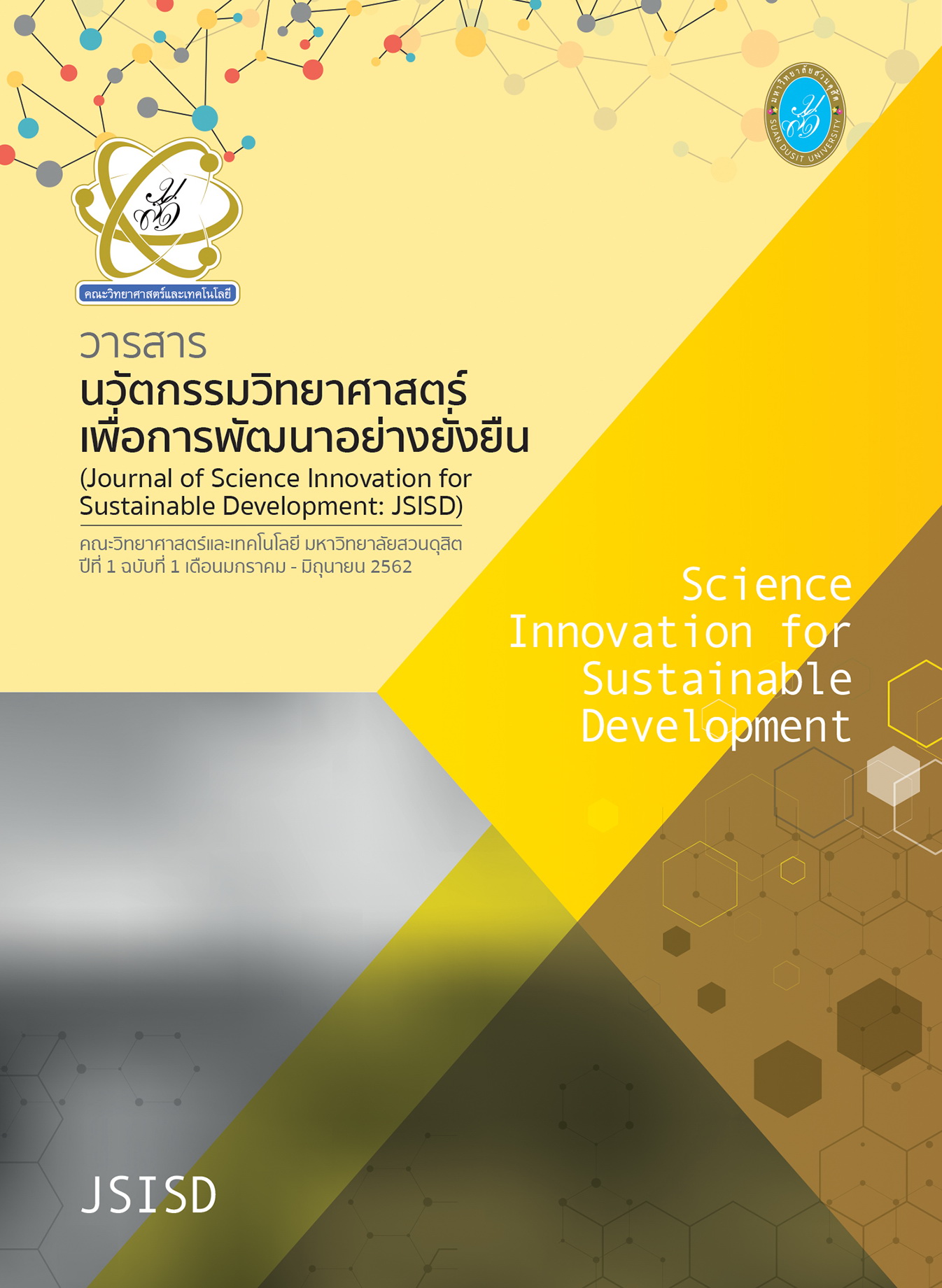แอปพลิเคชันออคเมนต์เต็ดเรียลลิตี้เรื่อง ระบบสุริยะ สำหรับนักเรียนที่บกพร่องทางการได้ยิน จักรดุลย์ เลียบสื่อตระกูล สุรศักดิ์ เสนาคำ กมล ตระการพงษ์ และ ฐิติยา เนตรวงษ์*
Main Article Content
บทคัดย่อ
โครงการนี้มีวัตถุประสงค์ 1) เพื่อพัฒนาแอปพลิเคชันออคเมนต์เต็ดเรียลลิตี้เรื่อง ระบบสุริยะ สำหรับนักเรียนที่บกพร่องทางการได้ยิน 2) เพื่อศึกษาความพึงพอใจของผู้ใช้แอปพลิเคชันออคเมนต์เต็ดเรียลลิตี้ กลุ่มตัวอย่างคือ ผู้เชี่ยวชาญ จำนวน 4 คน เพื่อประเมินประสิทธิภาพแอปพลิเคชัน และนักเรียนที่บกพร่องทางการได้ยิน โดยเลือกแบบเจาะจง จำนวน 5 คน จากโรงเรียนเศรษฐเสถียร เพื่อศึกษาความพึงพอใจในการใช้งานแอปพลิเคชันที่สร้างขึ้น ผลการวิจัยพบว่า 1) แอปพลิเคชันออคเมนต์เต็ดเรียลลิตี้เรื่อง ระบบสุริยะ สำหรับนักเรียนที่บกพร่องทางการได้ยิน ผู้เชี่ยวชาญพิจารณาประสิทธิภาพภาพรวมอยู่ในระดับมากที่สุด ( = 3.82, SD = 0.26) ด้านการออกแบบ (
= 3.80, SD = 0.25) ด้านเนื้อหา (
= 3.90, SD = 0.14) และด้านการใช้งาน (
= 3.75, SD = 0.31) 2) การใช้แอปพลิเคชันออคเมนต์เต็ดเรียลลิตี้เรื่อง ระบบสุริยะ สำหรับนักเรียนที่บกพร่องทางการได้ยินพบว่า ภาพรวมการใช้งานมีความพึงพอใจอยู่ในระดับมาก (
= 3.50, SD = 0.15)
Article Details

อนุญาตภายใต้เงื่อนไข Creative Commons Attribution-NonCommercial-NoDerivatives 4.0 International License.
ลิขสิทธิ์ต้นฉบับที่ได้รับการตีพิมพ์ในวารสารนวัตกรรมวิทยาศาสตร์เพื่อการพัฒนาอย่างยั่งยืนถือเป็นกรรมสิทธิ์ของคณะวิทยาศาสตร์และเทคโนโลยี มหาวิทยาลัยสวนดุสิต ห้ามผู้ใดนำข้อความทั้งหมดหรือบางส่วนไปพิมพ์ซ้ำ เว้นแต่จะได้รับอนุญาตอย่างเป็นลายลักษณ์อักษรจากคณะวิทยาศาสตร์และเทคโนโลยี มหาวิทยาลัยสวนดุสิต นอกจากนี้ เนื้อหาที่ปรากฎในบทความเป็นความรับผิดชอบของผู้เขียน ทั้งนี้ไม่รวมความผิดพลาดอันเกิดจากเทคนิคการพิมพ์
เอกสารอ้างอิง
กระทรวงพัฒนาสังคมและความมั่นคงของมนุษย์. (2561). สถิติคนพิการทางการได้ยิน. สืบค้นเมื่อ มีนาคม 3, 2562, จาก http://nadt.or.th/pages/stat61.html/.
จิรวดี โยยรัมย์ และสิทธิโชค น้อยเกิดพะเนาว์. (2562). การพัฒนาบทเรียนคอมพิวเตอร์ช่วยสอนสอดแทรกการ์ตูนแอนิเมชัน 2 มิติ ร่วมกับเทคโนโลยีความจริงเสมือน (AR) เรื่อง ดาราศาสตร์และอวกาศ สำหรับนักเรียนชั้นมัธยมศึกษาปีที่ 3. รายงานการประชุมวิชาการระดับชาติการจัดการเทคโนโลยีและนวัตกรรมครั้งที่ 5. มหาวิทยาลัยราชภัฏมหาสารคาม จังหวัดมหาสารคาม ประเทศไทย.
ปถมาภรณ์ ไทยโพธิ์ศรี และพัลลภ พิริยะสุรวงศ์. (2557). การเรียนรู้แบบผสมผสาน ด้วยเทคโนโลยีความจริงเพิ่มเติม. วารสารศึกษาศาสตร์ มหาวิทยาลัยนเรศวร. 16(3), 214–222.
พิชญสิสี พุทธิทวีศรี วรรณพรรธน์ ริมผดี และดลใจ ฆารเรือง. (2560). นวัตกรรมสร้างสรรค์ด้วยเทคโนโลยเสมือนจริง 3 มิติ เพื่อส่งเสริมการท่องเที่ยวเกาะรัตนโกสินทร์อย่างยั่งยืน. รายงานวิจัย มหาวิทยาลัยสวนดุสิต.
ศิวกร กระต่ายป้อง กันตพัฒน์ เกียรติศิรภัทร์ และลิสรา ไกรเพขร. (2558). การพัฒนาสื่อการสอนวิชาวิทยาศาสตร์หน่วยการเรียนรู้โลกดาราศาสตร์และอวกาศด้วยเทคโนโลยี ออคเมนต์เต็ดเรียลลิตี้ระดับชั้นมัธยมศึกษา. สืบค้นเมื่อ มีนาคม 29, 2562, จาก http://www.thaigoodview.com/library/teachershow/
phitsanulok/suwicha_p/index.htm/.
ศูนย์เทคโนโลยีทางการศึกษา. (2552). คลังสื่อดิจิทัล. สืบค้นเมื่อ ตุลาคม 20, 2561, จาก http://www.ceted.org/
index.php?option=com_allvideoshare&view=search.
Chow, J. et al. (2013). Music education using augmented reality with a head mounted display. Proceeding of the Fourteen Australasian User Interface Conference (AUIC2013), 73–79.
Saltan F. & Arshan, O. (2017). The use of augmented reality in formal education: A scoping review. EURASIA Journal of Mathematics Science and Technology Education. 13(2), 503–520.
Tarng, W. & Ou, K. L. (2012). A study of campus butterfly ecology learning system based on augmented reality and mobile learning. Proceeding of 7th IEEE International Conference on Wireless, Mobile and Ubiquitous Technology in Education, pp.62–66.
Vate-U-Lan, P. (2011). Augmented reality 3D pop-up children book: Instructional design for hybride learning. Proceeding of 5th IEEE International Conference on e-Learning in Industrial Electronics (ICELIE), pp.95–100.
White, J., Schmidt, D. & Golparvar-Fard, M. (2014). Application of augmented reality. Proceeding of the IEEE. 102(20, pp.120–123.


